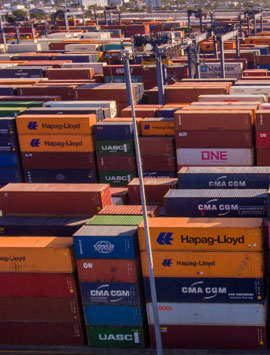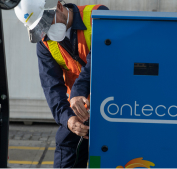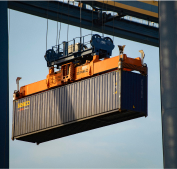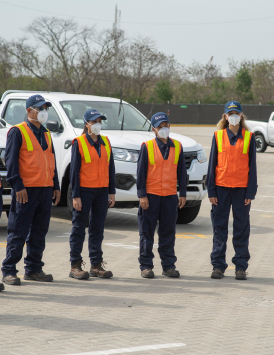Safety and security

Cargo generators, shipping agents, and other members of the maritime-port community rely on the Port of Cartagena Group for its high levels of security. In addition to complying with strict international standards and participating in various best practice initiatives, the organization employs all necessary resources for risk control and analysis.
All terminal perimeters are monitored by CCTV security cameras that allow on-site and remote monitoring of the access roads and the storage area to provide evidence of events occurring inside the terminals.
It has 45-meter lighting masts to cover all areas of the yard with its respective perimeter fence.
Finally, it has its own emergency team with its own fire truck, hazmat vehicle, and ambulance in case it is needed at any time.
The organization's strong commitment in this area includes staff training and state-of-the-art technology. This way, the integrity of cargo, vessels, terminals, equipment, and their users are safeguarded. For example, it has information systems that make it possible to define the potential risks that may arise during port operations.






Its different security systems include:
- Access control through smart ID credentials.
- Digital closed-circuit television, CCTV.
- Risk analysis.
- High-tech scanners to verify container and pallet contents.
- Technical restriction for unplanned load movements.
- Search and rescue canine team, antinarcotics, and explosives detector.
- Inflatable boats, divers, and submersibles for underwater security in the maritime terminals’ maritime area.
Programs, certifications, agreements, and best practices
-
 2012
2012National Center for Cargo Profiling, NTC
Connectivity and real-time information exchange are one of the strengths of the Port of Cartagena Group's security strategy. For this reason, an agreement was signed with the National Cargo Profiling Center (NTC) in Washington.
-
 2010
2010ATDI, a complement to CSI
Currently, there is an efficient exchange of information between the DIAN and the SPRC with the U.S. Customs and Border Protection Authority (CBP), which is fundamental in the risk analysis process for Colombian cargo. This is thanks to the fact that the Port of Cartagena Group has become the most advanced port in the world in the ATDI program.
What is ATDI?
The Advanced Trada Data Initiative (ATDI) is a voluntary CBP program whose purpose is to analyze commercial information that is not a legal requirement for entry of cargo into the United States. The initiative seeks to improve the ability to screen and track terrorism-related items in import cargoes through the use of enhanced trade information in risk management systems.
-
 2009
2009C-TPAT
This is a U.S. Customs initiative that seeks to forge a voluntary business coalition to prevent the use of legitimate trade for terrorism or related crimes. It was born as a strategy to consolidate the security of the cargo logistics chain. Incorporates its standards with BASC standards.
Megaports Initiative
As a parallel program to the CSI, the Megaports initiative, which is being carried out with the U.S. Department of Energy, was included. For this purpose, six radiation detection portals were installed at the SPRC and are operated by DIAN.
What is the Megaports initiative?
It is one of multiple components in the U.S. maritime security strategy. Seeks to provide equipment, training, and technical support to detect and prevent the smuggling of special nuclear materials and other radioactive elements in the international maritime system.
-
 2007
2007Container Security Initiative, CSI
The U.S. Customs and Border Protection Authority (CBP) found that the SPRC's information, technology, and security systems were highly developed. That is why the U.S. government decided to certify it as a CSI port.
What is CSI?
The Container Security Initiative (CSI) uses intelligence and automated information to identify containers of potential risk and focus inspection efforts. Efficient pre-inspection of high-risk containers is performed at the port of embarkation, using non-intrusive technology to detect hazardous material.
-
 2004
2004Ship and Port Facility Security
The organization's terminals, SPRC and Contecar, are certified by the International Maritime Organization under the International Ship and Port Facility Security Code (ISPS). These are part of the international order to detect and prevent acts that threaten ships or port facilities.
-
 2003
2003Law against bioterrorism
The Public Health Security and Bioterrorism Preparedness and Response Act of 2002 required entities that manufacture, process, pack, or hold food for human or animal consumption in the United States to register with the FDA by December 12, 2003. For this purpose, the port facilities of the SPRC and Contecar maritime terminals were registered. It is currently in effect.
-
 1998
1998Port Security Program, PSP
Agreement of Wills between the National Police, the Attorney General's Office, the U.S. Embassy, and the SPRC to develop a security scheme for trade with the United States.
BASC
Business Alliance for Secure Commerce (BASC) is an international business alliance that promotes secure trade, led by the private sector and supported by the U.S. Customs Service.
